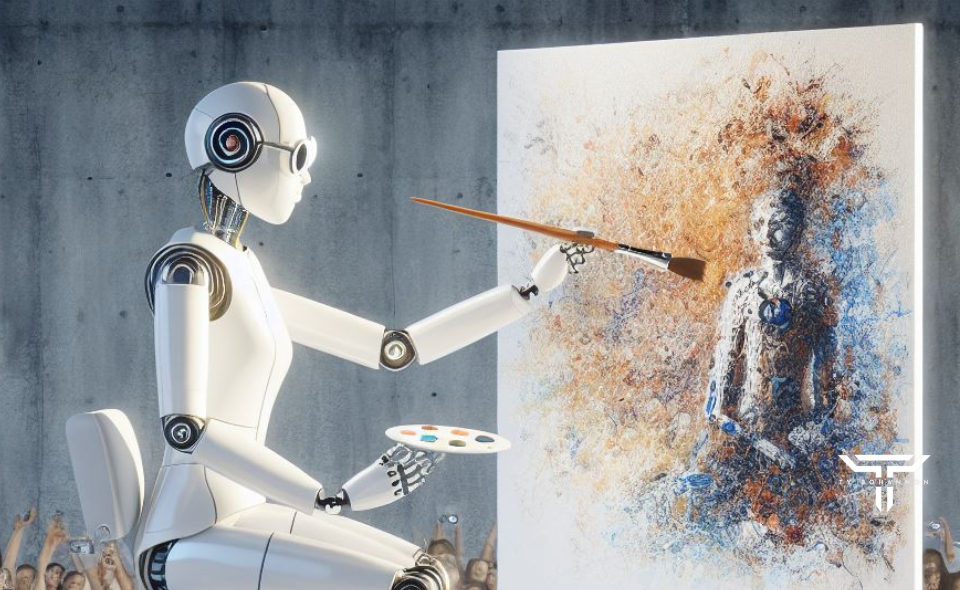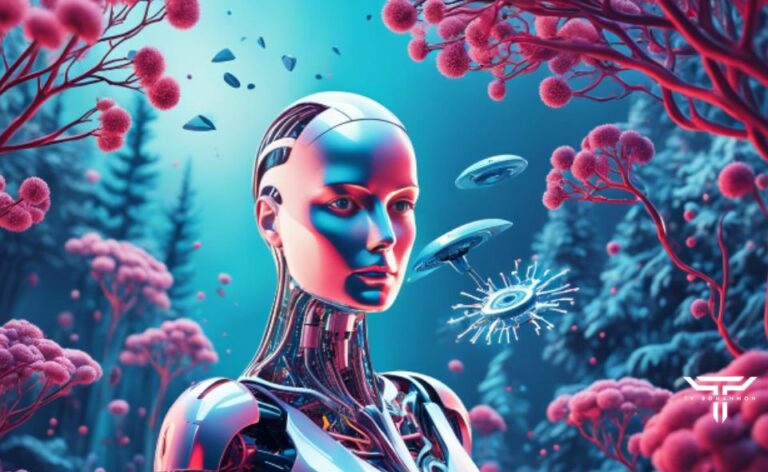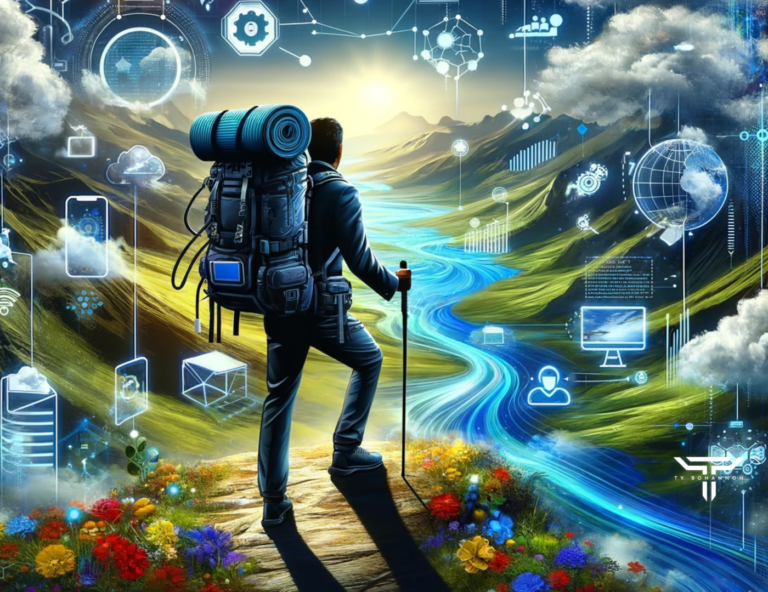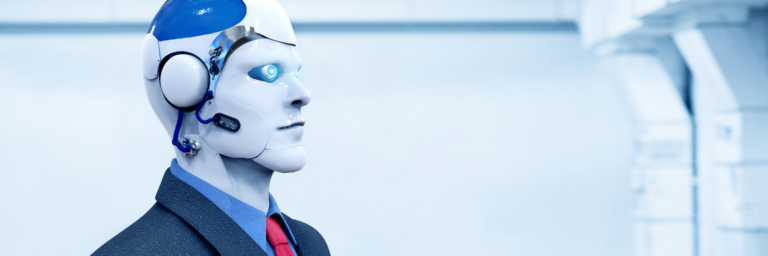Artistic AI: How Generative AI is Shaping Digital Art
In a world where technology and creativity collide, a remarkable evolution is taking place. It’s a transformation that blurs the lines between human ingenuity and artificial intelligence, where machines are becoming the unexpected muse for artists and creators.
It’s a journey into the heart of innovation, where algorithms paint canvases, compose symphonies, and craft stories.
Welcome to the intersection of art and artificial intelligence, where the boundaries of imagination are being pushed to the brink, and the very essence of what it means to be an artist is undergoing a profound redefinition.
Join me as I embark on an extraordinary exploration of this fascinating realm, where pixels meet poetry, and circuits give rise to masterpieces.
Unveiling the Magic: The Rise of Generative AI in Art

Generative AI in art is like unlocking a new world of creativity. Just as explorers discover new lands, artists and tech experts are exploring how AI can create art. This isn’t just any art – it’s something new and exciting.
AI uses data and algorithms, which are like sets of instructions, to make artworks that can surprise even the creators. This is a big deal in the art world. It’s like having a new kind of paint brush that paints by itself, creating images we’ve never seen before.
Artists are teaming up with machines to push the boundaries of creativity, and it’s changing how we think about art.
Crafting New Realities: The Mechanics of AI-Powered Creation
AI-powered creation works by feeding the AI lots of information about different art styles and techniques. Then, the AI uses this information to make new art.
It’s like teaching a super-smart student about art history and then asking them to create their own artwork. But, instead of a student, it’s a computer program. This program can analyze thousands of art pieces, learning what makes them beautiful or interesting.
Then, it uses that knowledge to create new pieces of art. This technology is not just copying; it’s learning and creating, which opens up a whole new world of possibilities for what art can be.
The Artist and the Algorithm: A Synergy of Minds
When artists and AI work together, it’s a partnership where each one brings something special to the table. The artist has imagination, emotions, and personal experiences, while the AI has speed, the ability to process huge amounts of data, and a different way of ‘seeing’ things.
This partnership can lead to amazing results. The artist guides the AI, kind of like a director in a movie, and the AI brings new ideas and techniques that the artist might not have thought of.
It’s a bit like having a super-smart assistant who can help you paint a picture or sculpt a statue in ways you never imagined.
Ethical Palette: Navigating the Morals of AI in Art
As AI starts creating art, we have to think about some big questions. Who is the real artist – the AI or the person who created the AI? And who owns the art that the AI makes?
These questions are important because they help us understand what it means to be creative and what art really is. It’s like asking, “If a robot writes a story, whose story is it?”
We need to think about these things to make sure that everyone is treated fairly and that AI is used in the best way possible in the world of art.
The Intersection of Technology and Creativity: AI’s Role in Artistic Innovation
Technology and creativity are coming together in amazing ways thanks to AI. Just like how smartphones changed the way we communicate, AI is changing the way we make art.
It’s giving artists new tools and methods to express their ideas. This technology isn’t just a tool; it’s like a partner in the creative process. It can help artists do things they couldn’t do before, like creating huge, complex images, or even helping them understand their own style better.
It’s a bit like having a magic wand that helps bring your most imaginative ideas to life.
From Pixels to Masterpieces: The Evolution of AI-Generated Imagery
AI-generated imagery has come a long way. In the beginning, it was simple – just basic shapes and colors. But now, it’s like the AI has learned to paint like the great artists of the past.
It can create images that are so detailed and beautiful that some people can’t tell they were made by a machine. This evolution is like watching a child grow up to be a talented artist.
The AI learns from each image it creates, getting better and better over time. It’s exciting to think about what kind of masterpieces it might create in the future.
Blending Worlds: How AI Transforms Traditional Art Techniques
AI is not just about creating new types of art; it’s also about adding a twist to traditional techniques. Imagine a painter who can blend the styles of Picasso and Van Gogh in one painting, or a sculptor who can carve details finer than any human hand.
That’s what AI is doing. It’s like a bridge between the old and the new, taking the best of traditional art and mixing it with modern technology. This blending is creating a whole new type of art that respects the past while looking forward to the future.
Breaking New Ground: AI’s Impact on Artistic Boundaries and Styles
AI in art is like a pioneer, exploring new territories of creativity. It’s not limited by the traditional rules of what art should look like. AI can mix colors, shapes, and ideas in ways that have never been tried before.
This is exciting because it means there are no limits to what can be created. It’s like opening a door to a room full of new colors and tools that no artist has ever used.
This freedom is changing the art world, encouraging artists to think outside the box and create things that are truly original.
The Voice of the Machine: Understanding AI’s Artistic Language
The ‘language’ of AI in art is unique. Unlike humans, AI doesn’t have feelings or personal experiences. Instead, it creates art based on patterns and data.
It’s like a new language made of numbers and codes. Understanding this language can help us appreciate what AI art is saying. Sometimes, the art made by AI can be surprising or even a little strange, but that’s because it’s a new way of expressing ideas.
It’s like hearing a new kind of music for the first time – it might sound different, but it can still be beautiful.
Global Canvas: How AI Art Is Influencing Cultural Landscapes
AI art is not just changing the way art looks; it’s changing how we think about art all around the world. It’s like a global conversation where everyone can share their ideas and styles.
AI art can mix styles from different countries and cultures, creating art that belongs to the whole world. This is important because it helps us see how connected we are.
Art made by AI can show us new perspectives and help us understand and appreciate other cultures in ways we never did before.
The Digital Renaissance: A New Era of Artistic Expression
We’re living in a time that could be called a ‘Digital Renaissance’ in art. Just like the Renaissance hundreds of years ago, this is a time of big changes and new ideas.
AI is helping artists break new ground and express themselves in ways that were impossible before. It’s an exciting time to be an artist or someone who loves art.
We’re seeing the birth of new kinds of art, and just like the masterpieces of the past, some of the art being created today might be remembered for hundreds of years.
Beyond the Canvas: AI as the New Artist’s Brush
AI is like a new kind of artist’s brush, but instead of just painting, it can do so much more. It can create images, sculptures, and even music.
This new ‘brush’ is helping artists experiment and find new ways to express their ideas. It’s not replacing the artist; it’s helping them grow.
Think of it like a new color that has never been seen before, and now artists can use it to make their paintings even more amazing.
The Collector’s Dilemma: Valuing and Collecting AI Artworks
Collecting AI art is a new adventure. It’s like being a treasure hunter, looking for the most interesting and beautiful pieces. But it’s also a bit of a puzzle because AI art is so new.
How do you decide what’s valuable or important? It’s like trying to guess which books will still be read in 100 years.
Collectors and art lovers are learning how to find and appreciate these new treasures, and as they do, they’re helping shape the future of art.
The Audience Perspective: Reception and Interaction with AI-Generated Art
How people see and interact with AI-generated art is really interesting. Some people are amazed by it, while others aren’t sure what to think.
It’s like when movies first came out, and people didn’t know how to react. AI art can make us question what we know about creativity and expression. When we look at art made by a machine, it can challenge our ideas about what art is and what it means to be an artist.
Through the Viewer’s Eyes: Public Perception of AI Art
The way people see AI art varies a lot. Some see it as the future of art, while others worry that it might take away from human artists. It’s a bit like how people have different opinions about new technology, like electric cars or space travel.
Understanding how people feel about AI art helps us understand not just the art itself, but also how technology is changing our world and the way we see things.
Charting New Territories: How AI is Redefining Artistic Interaction
AI is changing how we interact with art. It’s not just about looking at paintings on a wall anymore. Now, we can watch art being made in real-time, sometimes even changing while we watch.
It’s like a live performance where the artist is a machine. This new way of interacting with art is making us think differently about what it means to experience art. It’s more dynamic and interactive, almost like a conversation between the viewer and the artwork.
Navigating the Future: Predictions and Possibilities in AI-Driven Art
Thinking about the future of AI in art is like trying to imagine what the world will be like in 100 years. It’s full of possibilities. We might see art that changes based on our mood or art that we can step inside and experience in 3D. The only limit is our imagination.
As technology gets better, the art that AI can create will become even more amazing and surprising. We’re just at the beginning of this journey, and there’s so much more to come.
The Next Wave: Emerging Trends in AI and Digital Art
The trends in AI and digital art are always changing. It’s like fashion – what’s popular today might be different tomorrow. But some trends are starting to show up. We’re seeing more interactive art, where the viewer can be part of the creation.
We’re also seeing AI being used to explore new materials and techniques. It’s a bit like a scientist discovering new elements to add to the periodic table. These trends are giving us a sneak peek at what the future of art might look like.
Bridging Realities: AI’s Role in Augmented and Virtual Art Experiences
AI is also playing a big role in augmented and virtual reality art. This is like stepping into a painting or a sculpture and being able to walk around and see it from every angle.
It’s a completely new way to experience art. Imagine putting on a pair of glasses and suddenly being in a world created by an artist, where everything you see and hear is part of the artwork. This is not just about looking at art; it’s about being inside it. It’s a whole new world of possibilities for artists and art lovers alike.
Conclusive Contemplations: Moving Forward
As we journey through the evolving landscape of generative AI in art, it’s like standing at the edge of a new frontier. This is not just a technological advancement; it’s a cultural shift.
Generative AI is not merely a tool in the hands of artists; it’s a collaborator and inspiration. It’s akin to a dance between human intuition and machine precision, creating a harmony that produces something truly extraordinary.
Frequently Asked Questions (FAQs)
1. What exactly is Generative AI in Art?
Imagine a world where a computer program can paint, draw, or sculpt. That’s what Generative AI in art is! It’s like a super-smart assistant that uses data and algorithms to create artworks. These aren’t just random pictures; they’re complex, thought-provoking pieces that can sometimes even surprise the AI’s creators!
2. Is AI-created Art really considered ‘Art’?
This is a hot topic! Some say art is only art if a human makes it, while others think AI art is the next big thing. It’s like asking if photography was art when it first appeared. Just like any new form of expression, AI art is opening up new debates and ideas about what art truly is.
3. How does AI change the role of the traditional artist?
Think of AI as a new tool in an artist’s toolbox. It’s not replacing artists but giving them new ways to express their creativity. It’s like when painters first started using oil paints – it didn’t end painting; it transformed it!
4. Can AI understand and replicate human emotions in art?
AI can analyze and mimic styles and themes that often convey emotions, but it doesn’t ‘feel’ in the human sense. It’s more like a mirror reflecting our own emotions and experiences through art, which makes the whole thing pretty fascinating!
5. Will AI replace human artists?
No, it’s not about replacing but rather enhancing. AI brings a new dimension to art, much like how digital tools opened up new avenues for filmmakers and musicians. It’s a collaboration where both humans and AI bring their strengths to the table.
6. How do people react to AI-generated art?
Reactions vary! Some are amazed by the possibilities, while others are more cautious or skeptical. It’s like the first time people saw movies – a mix of wonder, curiosity, and a bit of uncertainty about what this means for the future.
7. What’s the future of AI in art?
The future looks bright and full of surprises! AI is like a canvas that’s constantly evolving, bringing new styles, techniques, and perspectives. It’s an exciting journey that’s just beginning, and who knows what incredible artworks are yet to be created!



